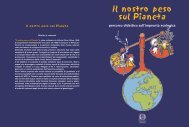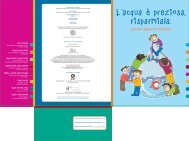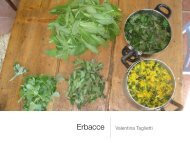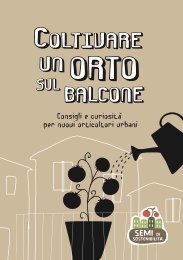Myanmar Protected Areas: Context, Current Status ... - Istituto Oikos
Myanmar Protected Areas: Context, Current Status ... - Istituto Oikos
Myanmar Protected Areas: Context, Current Status ... - Istituto Oikos
You also want an ePaper? Increase the reach of your titles
YUMPU automatically turns print PDFs into web optimized ePapers that Google loves.
Acknowledgments<br />
VI<br />
<strong>Myanmar</strong> <strong>Protected</strong> <strong>Areas</strong><br />
A. Bonetti<br />
The authors of this publication are researchers affiliated with <strong>Istituto</strong> <strong>Oikos</strong> and BANCA.<br />
Chapter 1 “<strong>Context</strong>” was written by Lara Beffasti (Project Manager, <strong>Istituto</strong> <strong>Oikos</strong>) and Valeria Galanti<br />
(Biologist, <strong>Istituto</strong> <strong>Oikos</strong>).<br />
Chapter 2 “<strong>Protected</strong> <strong>Areas</strong>” is co-authored by Lara Beffasti, Valeria Galanti and Tint Tun (Project Manager,<br />
BANCA). The maps were produced by Simone Bianchi (GIS expert, <strong>Istituto</strong> <strong>Oikos</strong>), Mi Mi Choe (GIS expert,<br />
Forest Department) and Thein Ko (GIS expert, BANCA) thanks to data provided by Forest Department<br />
and Wildlife Conservation Society, and data collected in the field. Photographs are by project staff in<br />
<strong>Myanmar</strong> during project period 2009-2010.<br />
Chapter 3 “In-depth study of Lampi Island Marine National Park” was written by Lara Beffasti and Valeria<br />
Galanti, also based on the reports of the field surveys undertaken between 2008 and 2010 by researchers<br />
affiliated to MEP and MABR projects listed in Table 15. Photos of the Myeik archipelago 2006-2007 have<br />
been made available by Andrea Bonetti (www.andreabonetti.com).<br />
Chapter 4 “In-depth study of Rakhine state” is co-authored by Simone Bianchi and Roberto Colombo<br />
(Researcher, Università Milano Bicocca).<br />
Chapter 5 “Conclusions and Recommendations” was written by Lara Beffasti and Valeria Galanti, also<br />
including the results of the stakeholder workshop held in Yangon in March 2011.<br />
Serena Arduino reviewed the draft text and provided valuable corrections and suggestions. Useful<br />
revisions and translations to and from <strong>Myanmar</strong> language were ably made by Tint Tun and Htoo Htoo.<br />
English language editorial support was provided by Guy Waley.<br />
The authors wish to express their gratitude for the valuable inputs and involvement to all <strong>Istituto</strong><br />
<strong>Oikos</strong>, BANCA and Forest Department staff and others who have made various contributions to the<br />
implementation of project activities or in the preparation of this publication and in particular to (in<br />
alphabetical order) U Aung Than, U Aye Myint Maung, U Bo Ni, Daw Dewi Thant San, Alessandra<br />
Gagliardi, Paola Mariani, Dr. Maung Maung Kyi, Dr. Maung Maung Than,U Maung Maung Thein Pe,<br />
U Myint Sein, Daw San San Nwe, Francesca Santapaola, Dr. San Win, U Saw Han, Dr. Saw Mon Theint,<br />
U Ohn, U Saw Tun Khaing, U Shein Gai Lai, Sara Stingelin, Daw Thandar Win, U Than Latt Shein, Daw Than<br />
Than Aye, U Tin Tun, U Tint Wai, Guido Tosi, Brunella Visaggi, U Win Maung and U Win Naing Thaw.<br />
We especially acknowledge U Uga, former Chairman of BANCA, who passed away in April 2010, and<br />
without whom this project would have not been possible.<br />
We warmly acknowledge Delphine Brissonneau, Programme Officer of the European Union Delegation,<br />
and Rossella Rossi, President of <strong>Istituto</strong> <strong>Oikos</strong>, who went beyond the call of duty in the support to the<br />
programme in <strong>Myanmar</strong>.<br />
<strong>Istituto</strong> <strong>Oikos</strong> is grateful to Luca Schueli for the invaluable introduction to <strong>Myanmar</strong>.<br />
All project team wish to thank the participants in all of the meetings, discussions and interviews<br />
organized by this project – villagers, scientists, foresters, protected area managers, NGO workers and<br />
executives alike – who shared the willingness to make a positive contribution to the conservation of<br />
<strong>Myanmar</strong> natural resources.<br />
1<br />
1.1<br />
1.2<br />
1.3<br />
2.<br />
2.1<br />
2.2<br />
Contents<br />
Forewords III<br />
Acknowledgements VI<br />
Acronyms used in the text VIII<br />
Introduction IX<br />
Executive Summary X<br />
Executive Summary (<strong>Myanmar</strong> language) XII<br />
Background on <strong>Myanmar</strong> 1<br />
Natural Features 1<br />
Environmental Policy and Practice 4<br />
Environmental Non-governmental<br />
Organizations (ENGOs) 8<br />
<strong>Myanmar</strong> <strong>Protected</strong> <strong>Areas</strong> 11<br />
Methodology 11<br />
Results 14<br />
Alaungdaw Kathapa 22<br />
Bawditataung 24<br />
Bumhpabum 26<br />
Chatthin 28<br />
Hlawga 30<br />
Hponkanrazi 32<br />
Htamanthi 33<br />
Hukaung Valley 34<br />
Hukaung Valley (Extension) 34<br />
Indawgyi Lake 36<br />
Inlay Lake 38<br />
Kahilu 40<br />
Kelatha 42<br />
Khakaborazi 44<br />
Kyaikhtiyoe 46<br />
Kyauk-Pan-Taung 48<br />
Lampi Island 50<br />
Lawkananda 52<br />
Lenya 54<br />
Lenya (Extension)* 54<br />
Loimwe 56<br />
Maharmyaing 58<br />
Mainmahla Kyun 60<br />
Minsontaung 62<br />
Minwuntaung 64<br />
Moscos Island 66<br />
Moyingyi Wetland 68<br />
Mulayit 70<br />
Natma Taung 72<br />
Panlaung-Pyadalin Cave 74<br />
Par Sar 76<br />
Pidaung 78<br />
Popa 80<br />
Pyin-O-Lwin 82<br />
Rakhine Yoma Elephant Range 84<br />
Shinpinkyetthauk 86<br />
Shwesettaw 88<br />
Shwe-U-Daung 90<br />
Tanintharyi National Park 92<br />
3.<br />
3.1<br />
3.2<br />
3.3<br />
4.<br />
4.1<br />
4.2<br />
4.3<br />
5.<br />
5.1<br />
5.2<br />
<strong>Myanmar</strong> <strong>Protected</strong> <strong>Areas</strong><br />
Tanintharyi Nature Reserve 94<br />
Taunggyi 96<br />
Thamihla Kyun 98<br />
Wenthtikan 99<br />
In-depth Study of Lampi Island Marine<br />
National Park 101<br />
Purpose 101<br />
Results 101<br />
Conclusions and recommendations 118<br />
Box 1 Plain-pouched Hornbill 119<br />
Box 2 Moken Sea Gypsies 120<br />
3.4 Checklist of Lampi MNP resources 122<br />
In-depth Study of Rakhine Yoma Elephant<br />
Range Wildlife Reserve 133<br />
Data and methods 135<br />
Results 139<br />
Conclusions and recommendations 144<br />
Conclusion 145<br />
Progress and priorities for <strong>Myanmar</strong> PAs 146<br />
Recommendations 146<br />
References 148<br />
Appendices 150






